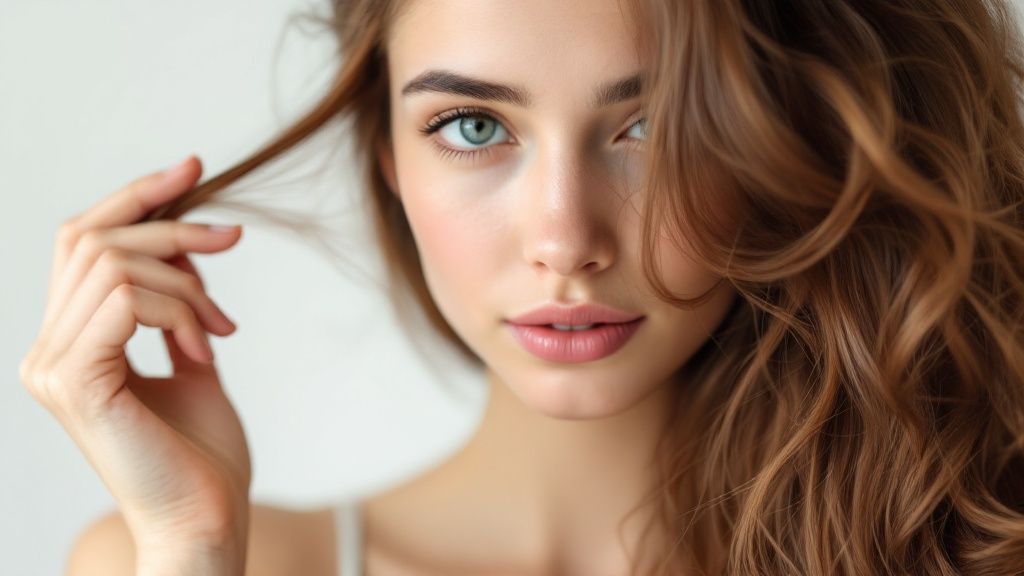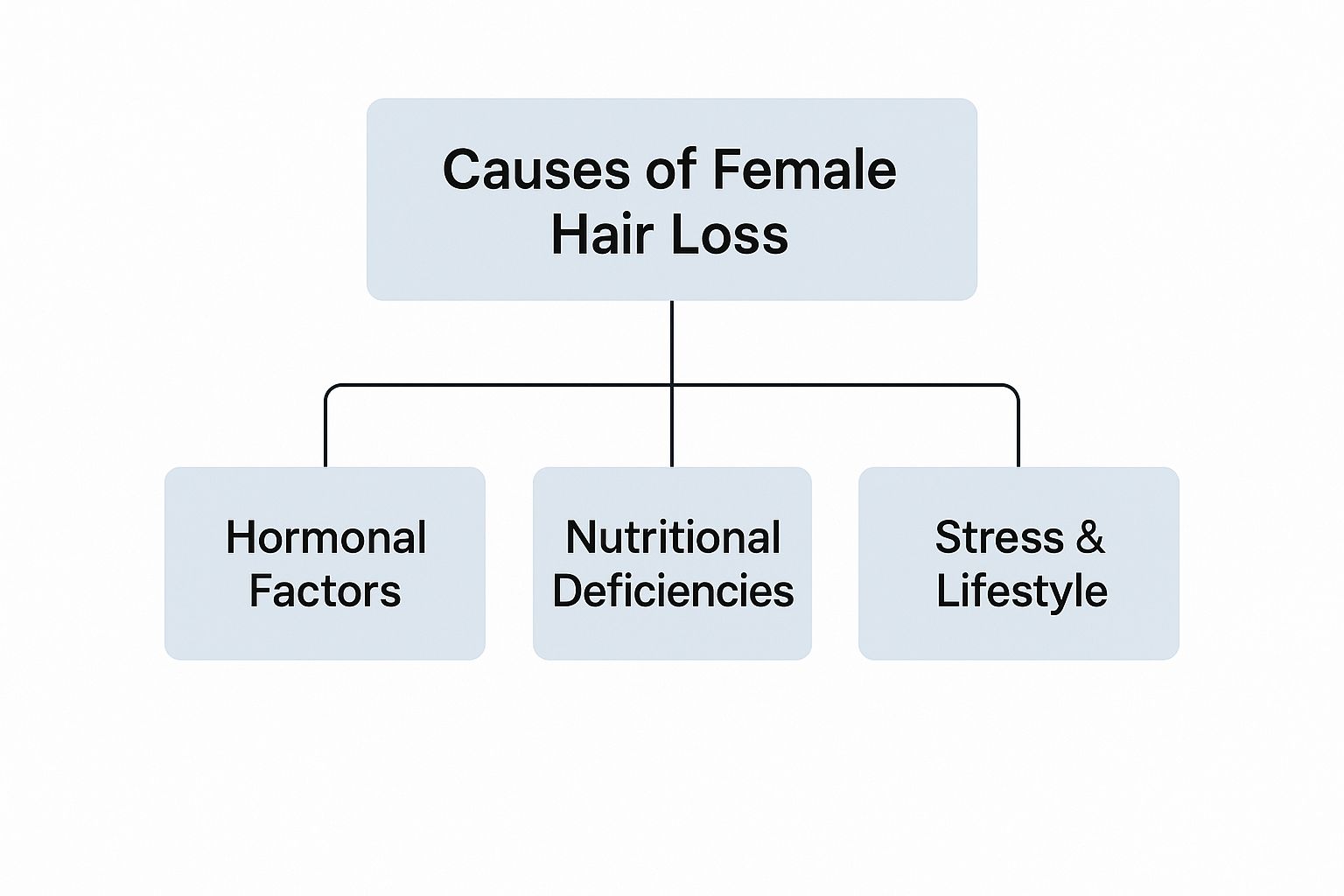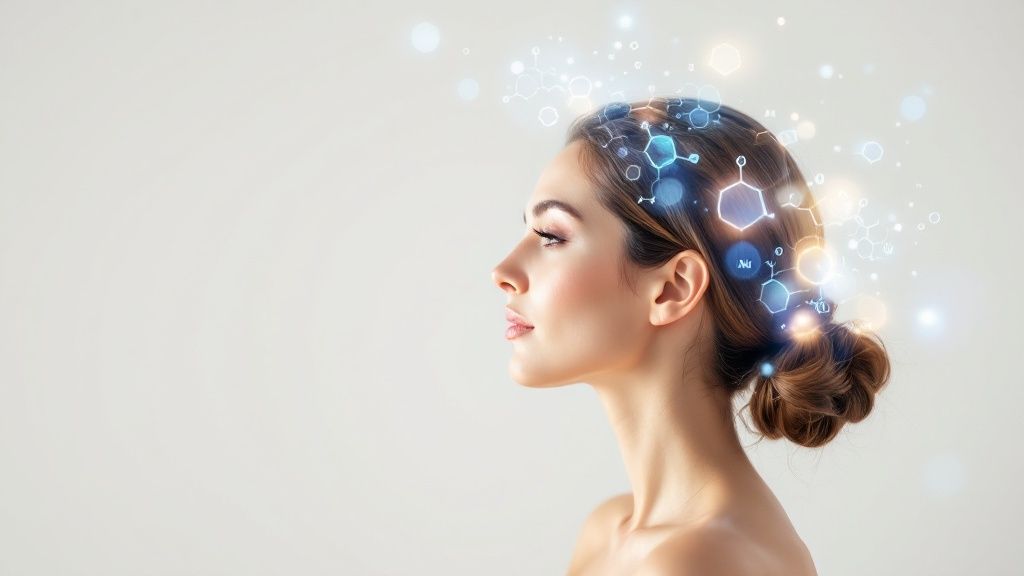
If you’re noticing more hair in your brush or a widening part, you’re not alone. Female hair loss is an incredibly complex puzzle, with pieces ranging from our genetics and hormones to the food we eat and the stress we carry.
It's rarely a single-cause issue. Instead, hair thinning in women often happens when a combination of factors throws the delicate ecosystem of your scalp and hair growth cycles out of balance. Getting to the root of these triggers is always the first, most empowering step.
Decoding the Reasons Behind Female Hair Loss
Finding clumps of hair in the shower drain or seeing your scalp more easily can be deeply personal and, frankly, stressful. The big question—what causes female hair loss—doesn't have one simple answer.
Think of your hair's health like a garden. For it to flourish, the soil (your scalp) needs the right balance of nutrients, hormones, and gentle care. When that balance gets disturbed, growth slows down, and things start to look a little sparse.
Most of the time, the problem can be traced back to a few key categories. These disruptions can shorten the active growth phase of your hair or push more strands into the shedding phase than usual, leading to noticeable thinning over time. It’s a multi-faceted issue affecting millions of women, making it a shared concern, not an isolated problem.
The Main Culprits Behind Hair Thinning
Understanding the root cause is everything because the right approach for hormonal hair loss is completely different from one caused by a nutritional gap. This is exactly why a one-size-fits-all remedy rarely delivers real results.
Here are the most common contributing factors:
- Hormonal Fluctuations: Major life events like menopause and pregnancy, or underlying conditions like thyroid disorders, can create massive hormonal shifts that directly impact your hair follicles.
- Genetic Predisposition: For many women, the tendency for hair thinning is simply inherited. This is known as Androgenetic Alopecia, or female pattern hair loss, and it's incredibly common.
- Nutritional Deficiencies: Your hair follicles are hungry. A lack of essential nutrients like iron, vitamin D, and zinc can literally starve them of the building blocks they need to grow strong hair.
- Stress and Lifestyle: High emotional stress and major physical stressors (like a serious illness, surgery, or even rapid weight loss) can shock the system, pushing a huge number of hair follicles into a resting phase all at once. The result? Sudden, noticeable shedding a few months later.
This quick guide summarizes the main triggers to help you pinpoint what might be going on.
A Quick Guide to Female Hair Loss Triggers
This table breaks down the primary categories that contribute to hair thinning in women, helping you quickly identify potential areas of concern.
| Cause Category | Common Examples | Typical Onset |
|---|---|---|
| Hormonal | Menopause, pregnancy, PCOS, thyroid issues | Gradual or sudden, often tied to life events |
| Genetic | Female Pattern Hair Loss (Androgenetic Alopecia) | Slow, progressive thinning, often after age 30 |
| Nutritional | Low iron, vitamin D, zinc, or protein | Gradual thinning, often with other symptoms |
| Medical | Autoimmune diseases, certain medications | Varies greatly depending on the condition |
| Lifestyle | High stress (Telogen Effluvium), harsh styling | Sudden shedding (stress) or breakage (styling) |
Each of these paths can lead to hair loss, which is why a holistic view is so important for finding a solution that actually works.

As you can see, internal factors like hormones and nutrition are just as important as external ones like stress. It all connects. In the next sections, we’ll dive deeper into each of these causes so you can get a clearer picture of what’s happening and what you can do about it.
When Your Family History Shapes Your Hairline

For so many women, thinning hair isn’t caused by a sudden shock or illness. Instead, it’s a quiet story written in their DNA, passed down through generations. This is the world of Androgenetic Alopecia, but you probably know it as female pattern hair loss. It’s not about dramatic clumps falling out in the shower; it’s a slow, progressive thinning that is, by far, the most common reason women lose their hair.
Think of your hair follicles as having a genetic "dimmer switch." Over the years, this switch slowly turns down the power, causing each follicle to shrink in a process called miniaturization. As the follicle gets smaller, the hair it grows becomes finer, shorter, and lighter in color. Eventually, it might stop producing hair altogether. This is why the change feels so gradual, almost sneaky.
This genetic programming revolves around androgens, a group of hormones that includes testosterone. While we often think of them as "male hormones," women produce them too. For those with Androgenetic Alopecia, hair follicles are genetically wired to overreact to dihydrotestosterone (DHT), a testosterone byproduct. It’s this sensitivity that flips the miniaturization switch on.
Recognizing the Signs of Genetic Hair Loss
Unlike the classic receding hairline or bald spot seen in men, female pattern hair loss shows up differently. The signs are usually more spread out and subtle, especially at first.
The most common clues include:
- A Widening Part: This is often the very first thing women notice. You might see a little more scalp peeking through your part line than you used to.
- Diffuse Thinning on Top: The thinning is most noticeable on the top and crown of your head. Your front hairline, however, usually stays put.
- A Skimpier Ponytail: Does your ponytail feel thinner? Do you have to wrap the elastic an extra time? This is a classic sign.
This pattern is precisely why many women don’t realize what’s happening until the thinning becomes more obvious. It’s more of a slow fade than a sudden exit.
Androgenetic Alopecia is incredibly common, a fact that can be strangely comforting. It’s one of the biggest causes of female hair loss, affecting roughly 33% of women worldwide at some point in their lives.
This isn’t some rare condition; it's a shared genetic reality for millions. Just knowing that can be the first step toward finding solutions and feeling less isolated.
The Power of Your Genetic Blueprint
So, how much does your family tree really matter? A whole lot. The hereditary link is incredibly strong. If your mother, aunts, or grandmother experienced thinning hair, your own risk is significantly higher. In fact, research shows that about 70.5% of women with hair loss have a family history of it, pointing to a powerful genetic connection. You can find more hair loss statistics and insights on Medihair.com.
It’s a myth that you can only inherit it from your mother’s side; these genes can come from either parent. This genetic legacy doesn't just determine if you're susceptible, but also the age thinning might start and how fast it progresses. For some, it begins in their 20s, while for others, it waits until after menopause, when hormonal shifts can hit the accelerator.
While you can't rewrite your genetic code, you can absolutely influence how it plays out. Understanding that your genes are a key factor empowers you to be proactive. You can seek out targeted treatments designed to fight miniaturization, effectively slowing down that dimmer switch and keeping your hair fuller for longer.
How Hormones and Stress Disrupt Hair Growth

While your genes might load the gun for hair thinning, it’s often your body's internal chemistry that pulls the trigger. Hormones and stress are two of the most powerful forces that can throw your hair’s natural growth cycle off-kilter, leading to sudden and confusing periods of shedding.
Think of your hair follicles as being in a constant, delicate dance of growing, resting, and shedding. When your internal world is calm and balanced, this dance is graceful and you barely notice it. But when a major hormonal shift or a wave of intense stress hits, it's like the music suddenly screeches to a halt, sending everything into chaos.
When Hormones Hit the Emergency Brake
Major life events are notorious for creating hormonal tidal waves that can directly impact your hair. Pregnancy, for instance, often brings a surge of estrogen that keeps hair in the growth phase longer. The result? That gloriously thick, lustrous mane many women enjoy.
But after childbirth, estrogen levels plummet. All that extra hair that was sticking around suddenly gets the signal to enter the shedding phase at once. This is postpartum telogen effluvium—a temporary but often dramatic hair loss that can be incredibly alarming for new moms.
Menopause brings its own set of hormonal hurdles. As estrogen levels decline, the relative influence of androgens (like testosterone) can increase. This shift can unmask or speed up genetic female pattern hair loss, causing follicles to shrink and produce finer, thinner strands over time.
Hormonal imbalances are one of the most common culprits behind sudden shedding. The key is to recognize that this type of hair loss is often a temporary response to a significant biological event, not necessarily a permanent change.
Conditions like Polycystic Ovary Syndrome (PCOS) are also frequent contributors to female hair loss. If you suspect an underlying issue, specific diagnostic tools like a PCOS clarity test can offer valuable insights. This is a critical step, because getting to the root of the hormonal imbalance is essential for restoring your hair's health.
The Cortisol Connection: Stress and Hair Shedding
Beyond major life events, the day-to-day pressure of modern life can also take a serious toll on your hair. Chronic stress floods your body with cortisol, a hormone that—in high doses—can prematurely push a large number of hair follicles from their active growing phase (anagen) straight into the resting phase (telogen).
A few months after a period of intense physical or emotional stress—like a major surgery, a serious illness, or a big life change—you might notice a sudden, widespread shedding. This delayed reaction is a classic sign of telogen effluvium, the same condition triggered by postpartum hormonal shifts. It's your body’s way of redirecting energy to vital functions, essentially putting hair growth on the back burner to deal with the crisis at hand.
The link isn't just anecdotal. Data shows that women with high stress levels are eleven times more likely to experience hair loss. It's also known that approximately 50% of women begin to notice hair loss by age 50—a time when both hormonal changes and life stressors often peak. Managing stress isn't just good for your mind; it's a critical part of a healthy hair strategy.
Supporting Your Scalp and Mind
When your body is under stress, supporting its recovery is vital. This means focusing on mental wellness practices, but also making sure your skin and scalp have what they need to thrive. Creating a healthy, calm environment for your follicles can make a huge difference.
One way to support overall skin wellness is with at-home treatments like the Barb N.P. Facial Mask. This device uses targeted LED light therapy to improve skin health, and those benefits can extend to your scalp.
- Wireless and Comfortable: Its practical, wireless design and comfortable fit make it effortless to use. You can relax and de-stress—a crucial part of any hair wellness plan—while the mask does its work.
- Three Lighting Settings: It features three targeted LED light therapies for different treatments. Red light helps stimulate cellular activity and circulation, blue light works to reduce bacteria and calm inflammation, and amber light focuses on rejuvenation and reducing redness.
By using this mask, you're not just caring for your facial skin; you're investing in a holistic approach to wellness that helps manage stress and supports a healthier environment for your scalp.
The Connection Between Your Health and Your Hair

Your hair is often the first, most visible report card for your internal health. When your body is humming along beautifully, your hair usually reflects that vitality with shine and strength. But the moment something goes off-kilter inside, your hair can be one of the first places to show it.
Think of your hair follicles as tiny, high-energy factories working around the clock. To do their job well, they need a constant, reliable supply of energy, oxygen, and nutrients from your bloodstream. If that supply chain gets disrupted by an underlying health issue, production slows down. The quality of what those follicles produce—your hair—suffers.
That’s why any sudden thinning or shedding should be a cue to look at the bigger picture of your well-being. It’s often your body's way of signaling that something deeper needs your attention.
When Your Diet Lacks Essential Nutrients
Growing healthy hair is like tending a lush garden; you can't expect vibrant growth from depleted soil. Your hair follicles are deeply rooted in your scalp, pulling life from the nutrients delivered by your blood. When key nutrients are in short supply, your body smartly prioritizes them for essential organs, leaving your hair follicles undernourished.
This is a huge factor in what causes female hair loss. A few key deficiencies are especially notorious for thinning hair:
- Iron: This mineral is critical for making hemoglobin, the protein in red blood cells that ferries oxygen everywhere. Low iron means less oxygen reaches your scalp, which can starve follicles and stall the growth cycle.
- Vitamin D: Often called the "sunshine vitamin," Vitamin D helps create new hair follicles. When your levels are low, it can literally put a stop to new hair growth before it even begins.
- Zinc: This is a powerhouse mineral for hair tissue growth and repair. It also keeps the oil glands around the follicles working properly, which is essential for a healthy scalp environment.
A nutrient-poor diet essentially puts your hair on a starvation diet. Closing those nutritional gaps is the foundational first step in any effective hair wellness plan, because it tackles the problem right at the root.
If you’re worried about nutritional gaps, exploring supplements for hair growth can offer targeted support to nourish your follicles from the inside out. Get more details here: https://barbnp.shop/blogs/news/supplements-for-hair-growth.
Deeper Medical Conditions and Hair Loss
Sometimes, thinning hair is a symptom of a much larger medical puzzle. Your body is a complex, interconnected system. When one area struggles, it can create a ripple effect that eventually reaches your scalp. Certain medical conditions are well-known for disrupting the hair growth cycle.
Thyroid disorders, for instance, are a classic culprit. Your thyroid gland produces hormones that regulate your metabolism. If it's overactive (hyperthyroidism) or underactive (hypothyroidism), the hormonal chaos can force a huge number of hair follicles into the resting phase at once, leading to widespread shedding.
Autoimmune conditions can also turn the body's defense system against itself. In the case of Alopecia Areata, the immune system mistakenly attacks healthy hair follicles, causing hair to fall out in small, often round, patches. Systemic health issues are often intertwined, and looking into the connection between probiotics and immunity can offer insights into maintaining overall wellness.
Daily Habits That Weaken Your Hair
While genetics and hormones are huge players in female hair loss, what we do to our hair every single day can be just as damaging. Think of it as a slow, steady erosion of your hair's strength. These external stressors often fly under the radar until the cumulative damage really starts to show up in the brush or on the scalp.
Many of these habits are so ingrained in our routines that we don’t even realize the strain they’re putting on our follicles. Over time, this constant physical stress can lead to breakage, thinning, and even a specific type of hair loss that’s completely preventable. Let's break down the biggest culprits.
The Problem with Persistent Pulling
One of the most direct ways we can harm our hair is simply by pulling it too tight. Severe buns, high ponytails, tight braids, and heavy extensions place a relentless strain on the hair follicles day in and day out. This constant tension can trigger a condition known as Traction Alopecia.
Imagine a tiny plant being constantly tugged at its roots. Eventually, that root system weakens and just lets go. That's exactly what’s happening to your hair follicles. The tension causes inflammation, damages the follicle—sometimes permanently—and stops it from producing new hair. You'll often see this as thinning around the hairline, temples, or the nape of the neck, where the pulling is most intense.
Traction Alopecia is a perfect example of how our styling choices can directly cause hair loss. The good news? It’s often reversible if you catch it early. By easing up on those tight styles and giving your hair a break, you allow the follicles to recover and start growing again.
Heat and Chemical Damage
Beyond just physical tension, the tools and treatments we use can be major offenders. Overusing heat styling tools—like flat irons, curling wands, and high-heat blow dryers—strips moisture from the hair shaft. This leaves your strands brittle, weak, and primed for breakage. While this isn't hair loss from the root, it absolutely contributes to the appearance of thinning by snapping strands mid-shaft and reducing your hair's overall volume and density.
Chemical treatments like bleaching, perming, and relaxing are even more aggressive. These processes fundamentally alter the hair's protein structure to get the color or texture you want. When they're done too often or incorrectly, they can cause such severe damage that you see significant breakage, making your hair look much thinner than it actually is. If this sounds familiar, you can discover more strategies on how to thicken thinning hair in our detailed guide.
Building a Foundation for Healthy Hair
To fight back against the daily wear and tear from styling and environmental stress, a solid at-home care routine is non-negotiable. It all starts with a healthy scalp—the literal foundation for strong hair growth. Just like healthy skin on your face is key to a radiant complexion, a healthy scalp is the bedrock of resilient, beautiful hair.
A fantastic way to support foundational skin health is by incorporating advanced treatments into your self-care rituals. The BARB N.P. Facial Mask, for instance, is a perfect example of technology designed to support overall skin wellness. While it's designed for your face, the core principles of promoting healthy skin apply everywhere.
The mask brings several key benefits that help create a better environment for your scalp and hair:
- Wireless and Comfortable: Its practical, wireless design and comfortable fit make it effortless to use. You can relax and de-stress—a crucial part of any hair wellness plan—while the mask does its work.
- Three Lighting Settings: It features three targeted LED light therapies for different treatments. Red light is known for boosting circulation, blue light helps purify the skin, and amber light focuses on rejuvenation.
By creating a routine that focuses on both gentle handling of your hair and foundational skin health, you give your hair the supportive environment it needs to thrive and stand up to daily damage.
Knowing When to See a Professional
Deciding to move from worrying at home to seeking professional advice can feel like a huge step, but it’s truly the most powerful thing you can do for your hair. If you’ve noticed persistent thinning, a sudden increase in shedding, or actual bald patches, it’s time to stop the guesswork. Trying to self-diagnose female hair loss is incredibly frustrating because the symptoms for different conditions often look exactly the same.
A dermatologist or a trichologist (a specialist in hair and scalp health) has the training and tools to see what’s really going on. They can pinpoint the root cause—whether it’s genetic, hormonal, a nutritional gap, or something else entirely. Getting that professional diagnosis is the critical first step toward creating a treatment plan that will actually work for you.
What to Expect During Your Consultation
Walking into your first appointment can be nerve-wracking, but knowing what’s coming can make it much easier. The entire goal of this first visit is for the specialist to gather information and connect the dots.
Be ready to talk about:
- Your Timeline: When did you first notice changes? Did the shedding come on suddenly, or has it been a slow, gradual thinning over time?
- Your Family History: Does hair loss run in your family? If so, on your mother’s or father’s side?
- Your Lifestyle: They’ll want to know about your diet, current stress levels, recent illnesses, new medications, and any major life events.
- Your Styling Habits: Be honest about tight hairstyles like ponytails or braids, chemical treatments, and how often you use heat tools.
After the conversation, they’ll do a physical examination. This usually involves taking a close look at your scalp with a magnifying scope to check on follicle health and hair density. They might also perform a gentle “hair pull test” to see how many strands come loose with minimal tension.
Getting a Clear Diagnosis
To uncover any hidden triggers, your doctor will likely recommend a few tests. Blood work is one of the most effective tools for spotting internal imbalances that contribute to hair loss. These tests can reveal crucial information about your thyroid function, iron levels (ferritin), vitamin D status, and key hormone levels.
Think of a consultation as hiring a detective for your hair. They use clues from your history, physical exam, and lab work to solve the mystery and create a targeted action plan. This data-driven approach replaces confusion with clarity.
Once you have a diagnosis, your specialist will walk you through potential treatments. These could range from topical solutions like minoxidil and prescription medications to address hormones, all the way to in-office procedures. For those looking at more advanced options, you can learn more about professional treatments like PRP for hair loss to see what modern aesthetics can offer.
Getting professional guidance ensures you invest your time, money, and hope into strategies with a real chance of success. It empowers you with a personalized roadmap to manage your hair health with confidence.
Answering Your Biggest Questions About Female Hair Loss
When you're dealing with hair loss, questions come up constantly. It's a confusing and often emotional journey. Here are some clear, straightforward answers to the concerns I hear most often from my clients.
Can Female Hair Loss Actually Be Reversed?
This is the big question, and the answer truly depends on what’s causing the shedding in the first place.
Think of it this way: if the hair loss is a reaction to a temporary stressor—like a recent surgery, a period of intense emotional stress, or the hormonal rollercoaster after having a baby—then yes, it's often completely reversible. Once your body finds its balance again, the hair usually grows back. The same goes for shedding caused by a nutritional gap; fixing the deficiency can restore normal growth.
However, for progressive, genetic conditions like Androgenetic Alopecia (female pattern hair loss), the game plan is different. Our goal isn't necessarily a full reversal to your teenage hair. Instead, treatment focuses on hitting the pause button on thinning, waking up dormant follicles, and holding onto the beautiful hair you still have.
What's the Very First Thing I'll Notice?
The first sign is different for everyone because there are different types of hair loss.
For female pattern hair loss, the most common clue is a slow, gradual widening of your part line. You might notice your ponytail feels a bit thinner or you can see more of your scalp under bright lights. It's sneaky because it happens over months or even years.
On the other hand, for sudden shedding conditions like telogen effluvium, the first sign is much more dramatic. You'll see a startling amount of hair in your brush, on your pillow, or in the shower drain. For something like alopecia areata, the initial sign is often finding a small, perfectly round, smooth bald patch seemingly out of nowhere.
Which Vitamin Deficiency Is the Biggest Culprit?
While a few different deficiencies can impact your hair, low iron is one of the most common and significant culprits I see in my practice.
Your body needs iron to produce hemoglobin, the protein that acts like an oxygen delivery service for all your cells—including the ones that build your hair. When your follicles don't get enough oxygen, they can't function properly, and growth stalls.
Other key players to keep an eye on are Vitamin D, which is crucial for creating brand new follicles, and Zinc, which is essential for hair tissue growth and repair.
At Barb N.P., we believe in a well-rounded approach to wellness, from expert aesthetic care to science-backed products that support your hair and skin health. Explore our curated solutions and book your consultation to start your journey toward renewed confidence. Learn more at https://barbnp.shop.

